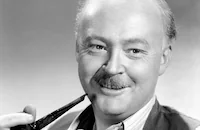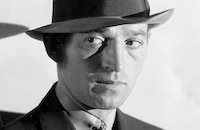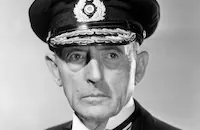The Face Behind the Mask

Brief Synopsis
Cast & Crew
Robert Florey
Peter Lorre
Evelyn Keyes
Don Beddoe
George E. Stone
John Tyrrell
Film Details
Technical Specs

Synopsis
Hungarian immigrant Janos Szabo docks in New York, brimming with enthusiasm for his new land. On the street he is befriended by police lieutenant Jim O'Hara, who sends him to Terry Finnegan's hotel. There, Janos rents a room and works as a dishwasher in the café, dreaming of the day when he will be able to send for his sweetheart in Hungary. Janos' dreams are shattered, however, when his face is hideously disfigured in a hotel fire. Feeling responsible for directing Janos to the hotel, O'Hara leaves a note for him at the hospital. Janos eagerly awaits the removal of his bandages so that he can look for work as a watchmaker but then sees his grisly reflection in the mirror. Unable to find employment because of his appearance, Janos writes his fiancée a farewell letter and is contemplating suicide when a passerby asks him for a match. Horrified by Janos' face, the man runs away, dropping his wallet in haste. Then, from out of the shadows steps Dinky, a petty thief who suggests they split the money in the man's wallet. Dinky and Janos become friends and roommates, but soon the money is gone and they are reduced to living in a junkyard. When Dinky becomes ill and desperately needs medical attention, Janos uses his mechanical aptitude to rob a safe. Janos' criminal abilities bring him to the attention of Watts and Benson, two former members of Dinky's gang, who propose they go into partnership. Hoping to raise enough money to pay for plastic surgery, Janos accepts their offer and visits Dr. Cheever, a plastic surgeon. Dr. Cheever is on vacation, but his assistant offers to make Janos a temporary mask until the doctor returns. Soon after Janos and his gang rob the opera box office, Jeff Jeffries, the gang's former leader who has just been released from prison, arrives to challenge Janos' authority. Janos appeases Jeff by offering him a cut from the robbery and welcoming him to join the reconstituted gang. Janos' new mask conceals his hideous appearance, but when Dr. Cheever offers no hope for surgery, Janos angrily runs out of the office and into the street, where he collides with Helen Williams, a blind girl. Janos offers to carry Helen's boxes of beads home, and a friendship springs up between the disfigured man and the sightless girl. When Helen tells Janos that she is content to live in a world of sounds, he bitterly spits out the story of his disfigurement and receives sympathy from Helen. Later, when Helen hears a radio broadcast discussing Janos' most recent theft, she denounces the robbers, and Janos decides to go straight. After announcing his intentions to the gang, Janos gives Dinky his new address and confides that has bought a house in the country and plans to marry Helen. Jeff, however, is suspicious of Janos' motives, and when he finds the card that O'Hara gave Janos in the hospital, he is certain he has been double-crossed and beats Janos' address out of Dinky. The next morning, Janos drives Helen to their new house. As they sit down to their first breakfast together, Jeff arrives to interrupt their newfound tranquility. While Jeff occupies Janos in the house, the others plant a bomb in his car. Their task completed, the gang drives off and then shoots Dinky, pushing him out of the car and leaving him for dead. Wounded, Dinky drags himself to a gas station to warn Janos about the bomb. Because Janos does not have a phone, Dinky calls his neighbors and asks them to bring him to the phone. As Janos drives away with his neighbors, Helen decides to unpack the car. When Dinky warns him about the bomb, which is connected to the car radio, Janos rushes home, arriving just as Helen turns on the radio and detonates the bomb. After Helen dies in his arms, Janos visits Dinky and learns of Jeff's plans to fly to Mexico that night. Janos forces Dinky to promise that he will return home to his mother and buy a farm, and then leaves. Soon after, O'Hara receives an anonymous letter, informing him that Jeff's gang can be found in a patch of the Arizona desert one week from Friday and instructing him that the reward is to be paid to Dinky's mother. Meanwhile, Jeff and the others board the plane for Mexico, unaware that Janos is their pilot. Janos lands the plane in the desert, sentencing them to die. After tying Janos to the plane, the gang, crazed with thirst, strikes out into the desert to look for help. One week later, O'Hara arrives to keep his appointment and finds the bodies scattered throughout the desert and a note on Janos' body thanking him for his kindness.

Director

Robert Florey
Cast

Peter Lorre

Evelyn Keyes

Don Beddoe

George E. Stone
John Tyrrell
Stanley Brown
Al Seymour
James Seay
Warren Ashe
Charles Wilson

George Mckay
Ben Taggart
Mary Currier
Sarah Edwards

Frank Reicher
Ralph Peters
Al Hill
Walter Soderling
Lee Prather
David Oliver
John Dilson
Joel Friedkin

Lee Phelps
Sam Ash
Ed Stanley
Claire Rochelle
Walter Merrill
Harry Strang
Al Bridge
Lee Shumway
Eddie Foster
Chuck Hamilton
Bill Lally
Al Rhein
Ernie Adams
Victor Travers
E. L. Dale
Almeda Fowler
Bessie Wade
Jack Gardner
Crew
Lionel Banks
Irving Briskin
Milton Carter
George Cooper
Paul Jarrico
Arthur Levinson
Wallace Macdonald
William Mull
Charles Nelson
Franz Planer
M. W. Stoloff
Allen Vincent

Videos
Movie Clip




Film Details
Technical Specs

Articles
The Face Behind the Mask
In a role that could be seen as autobiographical and a metaphor for Lorre's declining fortunes in the film industry, The Face Behind the Mask introduces us to Janos Szabo, a Hungarian immigrant who arrives in New York City full of hope and dreams about the new opportunities awaiting him. Delighted to find any work at all, he takes a job as a dishwasher but tragedy strikes when he is severely burned in a rooming house fire. Unable to find work because of his horribly scarred face, Janos contemplates suicide on the waterfront but is distracted from his melancholy by a two-bit hoodlum named Dinky (George E. Stone) who takes him in and introduces him to a life of crime. Motivated by his desperate desire to appear normal again (through the miracle of plastic surgery), Janos dons a life-like rubber mask and becomes an accomplished master thief and ringleader of a criminal gang, all the while amassing the necessary funds for his expensive operation. His obsessive self-interest, however, fades when he meets Helen (Evelyn Keyes), a blind woman whose optimistic outlook on life changes him, despite her impoverished circumstances. Their love affair and subsequent marriage provides a brief respite of tenderness before The Face Behind the Mask enters its tragic final act in which Janos's gang turns against him and plots a revenge that backfires in disaster for all. The climax, set in a desolate stretch of desert with Janos tied to an abandoned plane, is a bleak counterpoint to the immigrant's hopeful beginnings. More than anything, The Face Behind the Mask is a vision of the American dream gone horribly wrong but under the artful direction of Robert Florey along with Franz F. Planer's atmospheric cinematography and Lorre's sensitive performance, it becomes a rich, multi-layered character study, a gem among the Columbia Pictures programmers of the forties.
The film also manages in its brief sixty-nine minute running time to look beyond the clichés of most crime melodramas of its period to depict some truly idiosyncratic streetwise characters, particularly Dinky. He is the only person to accept Janos as he is and not register shock or repulsion at his mutilated features. Their sense of loyalty to each other as the film progresses is as touching in its own way as Janos's tender romance with Helen. Florey also takes great care to evoke both pity and compassion in scenes that normally would be played for sheer horror in the hands of other directors. For instance, the scene in which Lorre's head bandages (a precursor to Edith Scob's tormented heroine of Eyes Without a Face, 1960) are removed for him to see focuses on the reactions of the nurse as she nervously watches in anticipation until the grim reality registers on her face. Florey also avoids any explicit close-ups of Lorre's destroyed face choosing instead to reveal it briefly and in partial shadow as Lorre glimpses himself in a wardrobe mirror before going berserk with despair.
Based on the radio play by Thomas Edward O'Connell, The Face Behind the Mask was not a film that Lorre held in high esteem. His co-star Don Beddoe, who plays the police officer who befriends Janos in the film, once said, "I don't think Peter was very much impressed with The Face Behind the Mask. His other successes, such as M, made him pretty blasé about this particular venture."
Lorre could also be a difficult actor to direct at times. According to Stephen D. Youngkin in The Lost One: A Life of Peter Lorre, "While waiting for filming to begin [on location at the Oxnard sand dunes], he [Lorre] drank his breakfast, a glass of Pernod, then another mixed with a split of Moet. Disquieted, director Robert Florey sat and listened to Lorre joke about needing liquid refreshment to forget the silly dialogue and grimaces called for the role. The actor promised to behave, said Florey, but "didn't keep his word and he didn't hold his liquor well. I could handle him till lunch time without much difficulty, but as the afternoon progressed Peter foundered into a world of his own, becoming gloomy or playful, melancholy or senseless, not taking direction but never hostile...I tried to get all his important scenes photographed during the morning hours, which was not always possible."
Like his character in The Face Behind the Mask, Lorre had undergone some physical changes since his last film, You'll Find Out. His decaying teeth, which had troubled him for years and resulted in pyorrhea and chronic bad breath, were finally replaced with dentures, softening his features considerably. It also may have been a factor in earning him more prominent supporting roles beginning that same year with They Met in Bombay and The Maltese Falcon.
In terms of his actual makeup for The Face Behind the Mask, Lorre stated "I put on dead white make-up, used two strips of adhesive tape to immobilize the sides of my face, and for the rest of it I used my own facial expression to give the illusion of a mask." Despite Lorre's low regard for the film, he delivers a remarkable performance, considering the limitations of the mask, and conveys an astonishing range of emotions from childish glee to mindless rage to deep depression to cool detachment to a blissful spiritual state. Few reviewers at the time singled out his performance for praise or even acknowledged that The Face Behind the Mask was something more than a routine programmer, despite the fact that its popularity encouraged Columbia Pictures to re-release it two years later. In fact, Variety dismissed the film with "It's not so much likely to scare audiences as make them a little sick...it's all too unpleasant." Sixty-five years later, The Face Behind the Mask enjoys a considerably better reputation. Phil Hardy's authoritative reference work, The Encyclopedia of Horror Films, regards it as "A marvelous little film...Florey's subtly stylized direction, Planer's superb camerawork and first-rate performances (Lorre, cleverly made up, has rarely been better) weave it into a miracle of tenderness."
Producer: Irving Briskin, Wallace MacDonald
Director: Robert Florey
Screenplay: Paul Jarrico, Allen Vincent, Arthur Levinson (story), Thomas Edward O'Connell (play)
Cinematography: Franz Planer
Film Editing: Charles Nelson
Art Direction: Lionel Banks
Music: Sidney Cutner
Cast: Peter Lorre (Janos Szabo), Evelyn Keyes (Helen Williams), Don Beddoe (Lt. James O'Hara), George E. Stone (Dinky), John Tyrrell (Watts), Al Seymour (Benson).
BW-69m.
by Jeff Stafford
SOURCES:
The Lost One: A Life of Peter Lorre by Stephen D. Youngkin

The Face Behind the Mask
Noir City 2008 Report, Part 3 - The Grand Inquisitor, Stranger on the Third Floor, & The Face Behind the Mask Unveiled at NOIR CITY 2008 in Los Angeles
Hunt initially protests the claims as ludicrous, but slowly we realize that perhaps Dashe is onto something. Since the story is inspired by the world of noir, things inevitably turn darker and more ominous, and soon it's clear that Dashe was foolish not to tell anyone where she was going this day. Hunt looks marvelous at 90 and gives the part her all, right through the disturbing and shocking finale. Hunt was at the screening and took part in a lively Q&A afterward with Muller.
The evening then moved on to the two Peter Lorre movies. Stranger on the Third Floor (1940) is not as rare as it once was; it pops up on TCM from time to time. Many consider it the first true film noir, and a programming article I previously wrote on its production can be found elsewhere on tcm.com. Seeing it again in such a nice print with a sizable audience was a pleasure. Van Nest Polgase's imaginative production design has great impact on the big screen; the nightmare sequence remains a stunning piece of expressionism which not only visualizes a character's (John McGuire's) paranoia but also makes serious comments on America's imperfect justice system. There are few better-realized dream sequences out there. As a whole, it's an amazing movie considering it runs 64 minutes and was so, so cheaply made.
Peter Lorre made The Face Behind the Mask (1941) soon after Stranger on the Third Floor, and it gives him a full leading-man, romantic role. It's worth remembering that while Lorre tends to be remembered fondly for his character parts in films like Casablanca and The Maltese Falcon, he was by 1940 totally established. Not only had he been a full-fledged star in over a dozen German films, most famously M (1931), he had been top-lining American movies like Mad Love (1935) and the Mr. Moto series since arriving in Hollywood.
He's awfully sympathetic in The Face Behind the Mask as a Hungarian immigrant newly arrived in New York. His character is armed with an appealing mixture of naivete and total enthusiasm for America and the opportunities it provides those willing to work. And Lorre is willing to work. Experienced in both watchmaking and aircraft maintenance, his upbeat personality wins him friends easily, and he takes a job as a dishwasher in the cheap boarding house he moves into. A fire breaks out one night, however, and Lorre is left with a horrendously disfigured face - shown to us a few brief but effective times.
Lorre now can't get work; his face is too horrible for anyone to bear. Desperate for money for plastic surgery, he turns to a life of crime. He is very successful at it and eventually is rolling in dough. His face is too far gone for reconstructive surgery, however, and he must settle for a mask, built by a doctor working from Lorre's passport photo. He continues to conduct robberies until he meets a blind woman (Evelyn Keyes) with whom he falls in love. But when his cohorts kill her (with a bomb meant for Lorre), he gets his revenge in a bizarre finale that finds everyone crash landing in the middle of the Arizona desert and dying painful deaths. Lorre's death is essentially suicide, though he takes the bad guys down with him.
There are other pulpy scenes of violence in this film, including a brutal torture sequence, and Lorre builds much sympathy as we see the world refusing to give him a chance no matter how hard he tries. His journey from optimism to alienation is a bleak and very "noir" one, and the ending is certainly true to what has been established. Lorre spends quite a bit of time before he gets his mask with his back to the camera, or in shadow, his face hidden from us, and as a result his dialogue sounds like voiceover. This has an interesting effect of building subjectivity; the de facto voiceover allows us to enter his psyche in a more direct way, and our sympathy deepens because of it.
Lorre describes his situation at one point as "a horrible nightmare from which I can never awake. " He doesn't.
By Jeremy Arnold
Noir City 2008 Report, Part 3 - The Grand Inquisitor, Stranger on the Third Floor, & The Face Behind the Mask Unveiled at NOIR CITY 2008 in Los Angeles
Quotes
Trivia
Notes
The film opens with the following prologue: "Just a few years ago-when a voyage to America meant adventure and not flight...when a quota was a number-and not a lottery prize to be captured by a lucky few..." A pre-production news item in Film Daily lists Irmgard von Cube as the film's author, but the extent of von Cube's contribution to the released film has not been determined. This was director Robert Florey's first picture under his Columbia contract. According to a modern source, Peter Lorre's "mask" was created by using white powder and two pieces of tape.














